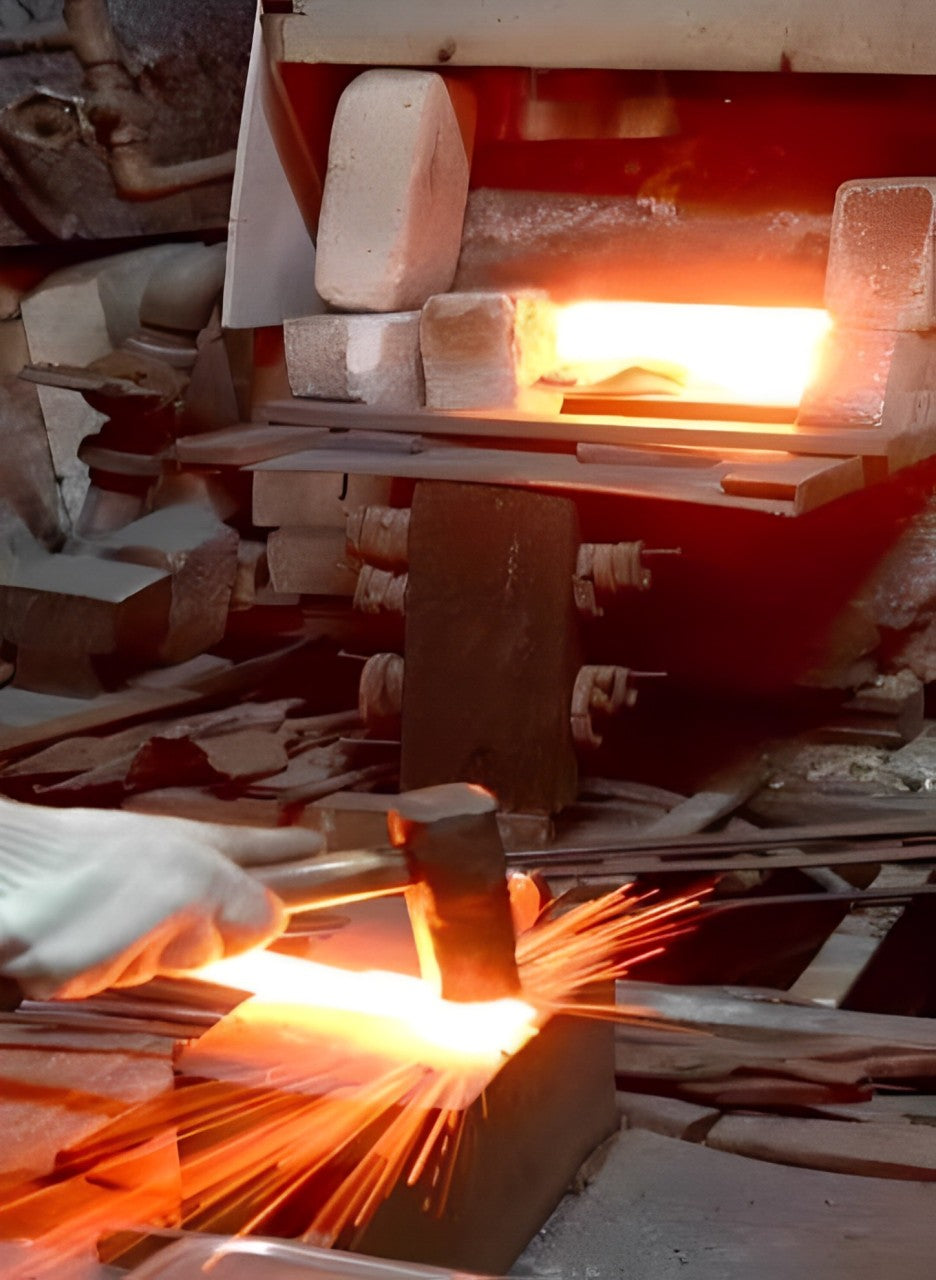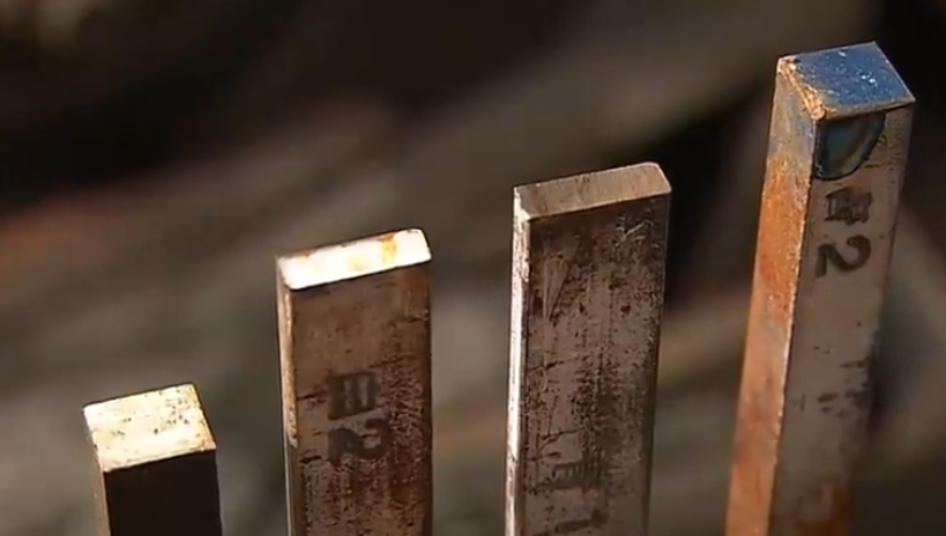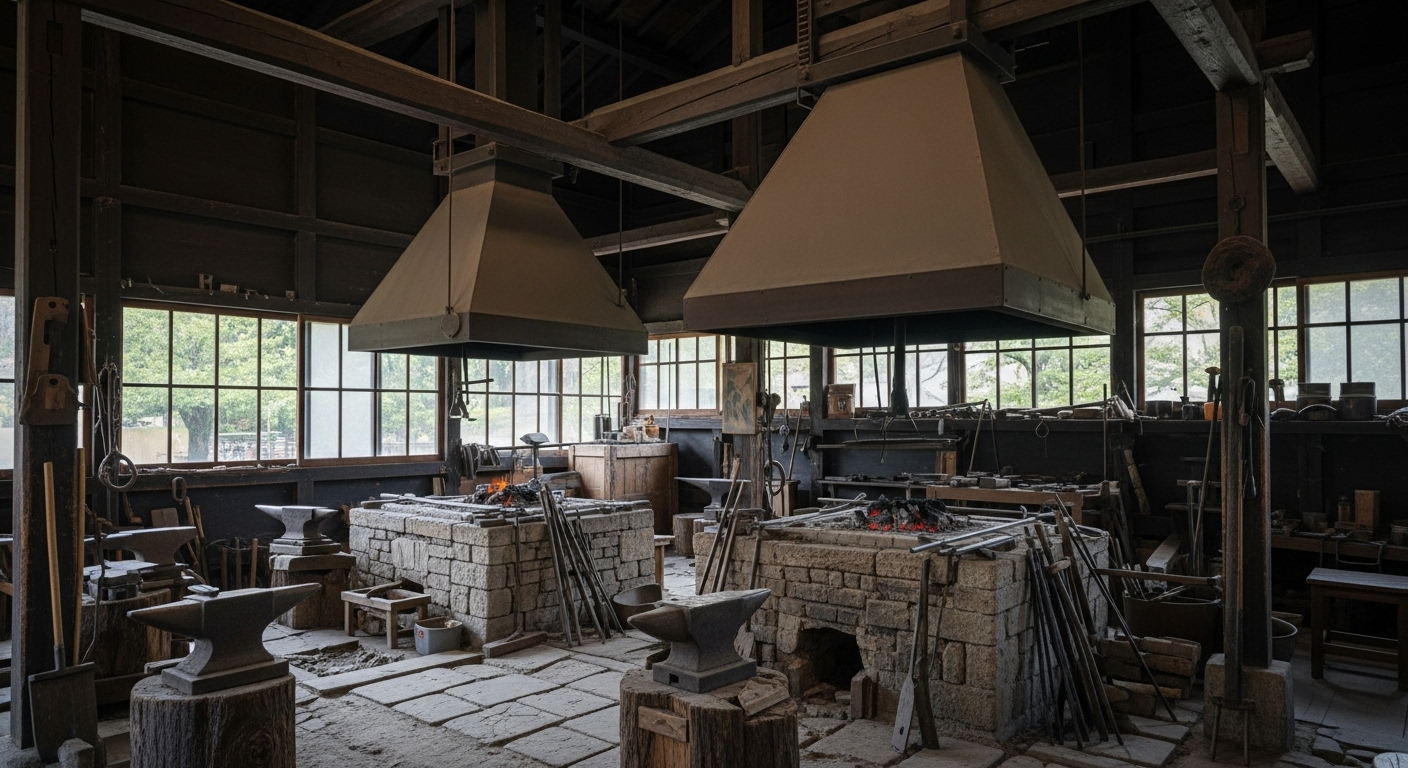
Japanese Knife Materials
-
From Iron to Stainless: The Evolution of Blade Materials
The true character of a Japanese knife lies in its steel.
This video takes you on a journey through the evolution of knife materials — from iron to carbon steel to stainless steel — revealing how each step shapes sharpness, durability, and ease of care. -
1. The Basics of Knife Steel
-
Why does knife steel matter so much?
When buying a car, you check the engine. When choosing wine, you consider the grape variety.
In the same way, understanding the steel at the heart of a knife reveals what truly sets it apart.Even if two knives look similar, different steel means completely different performance.
For example, the steel determines:
-
- Sharpness: Can it bring out the full flavor of your ingredients?
- Edge retention: How long does that sharpness last?
- Ease of maintenance: How much care does it require?
All of this depends on the steel.
-
The First Step to Transform Your Cooking
A knife made from good steel is not just a tool.
It’s a lifelong partner that transforms daily cooking into moments of discovery and joy.Let’s explore the world of Japanese knife steel together.
-
The Evolution of Knife Steel — The Three Stages

Stage 1: Iron — The Foundation of It All
Steel is created by adding elements to iron to form an alloy.
The five key components are:
- C (Carbon): Source of hardness
- Si (Silicon): Stabilizes strength
- Mn (Manganese): Improves toughness
- P (Phosphorus): Adjusts strength
- S (Sulfur): Improves workability
Why it matters:
At this stage, it cannot yet be used as a knife.
- Too soft for cutting
- Rusts immediately
- Breaks easily with slight impact
-
Stage 2: Carbon Steel (Iron + Carbon)
By adding carbon to iron, we achieve performance suitable for knives.
Advantages:
- Dramatic improvement in hardness: Cutting performance becomes significantly better
- Easy to sharpen: Simple edge setting and razor-sharp performance
Disadvantages:
- Prone to rust: Vulnerable to moisture, requires frequent maintenance
- Brittleness: Being hard makes it prone to chipping
Carbon steel is still highly valued by professionals as “sharpness-focused” knives. -
Stage 3: Stainless Steel (Carbon Steel + Chromium + Tungsten)
To overcome carbon steel’s weakness of rusting, stainless steel was created by adding 10.5% or more chromium (Cr). This gave birth to modern knives.
Effects of Chromium:
- Dramatic improvement in rust resistance: Strong against oxidation, difficult to rust
(Supplementary) About Tungsten (W):
Sometimes added in high-grade steels. Improves hardness, wear resistance, and heat stability, but not all stainless knives contain tungsten.Characteristics of Modern Stainless Steel:
- Balanced: Good sharpness, durability, and maintainability
- Versatile: Suitable for both home and professional use
- Safe: Low risk of food contamination due to rust
-

The Meaning of Evolution
This 3-stage evolution is not just technical progress.
Each stage reflects solutions tailored to user needs and environments.With this understanding, you’ll be able to choose the optimal knife material for your cooking style.
In the next chapter, we’ll dive deeper into the specific materials and how to select the right one.
2. Carbon Steel — The Edge Chosen by Masters
-
2.1 Why Carbon Steel?
Many chefs say, “A knife is the soul of a cook.”
And in many of the world’s top kitchens, you’ll still find simple, unadorned carbon steel knives. -

Why? Because of uncompromising sharpness.
- Slices tomatoes cleanly without releasing excess moisture
- Cuts onions without crushing fibers, minimizing harshness
- Fillets fish into pristine flakes that hold their form beautifully
The Science Behind the Edge
Carbon steel has a simple composition, which makes it easy to sharpen and capable of producing a razor-thin edge.
In contrast, stainless steel resists rust but is generally harder to keep at maximum sharpness.Caring for Your Knife = Deepening the Bond
Yes, carbon steel rusts more easily.
Yes, it requires more care.But therein lies its charm:
- Wipe it after every use
- Resharpen it regularly
- Watch the blade develop a unique patina over time
Much like polishing leather shoes or tending a bonsai tree, caring for a carbon steel knife builds a lifelong connection. Some chefs have used the same blade for 30 or even 40 years—a true partner in their craft. -

-
2.2 The World of Yasuki Steel — Japan’s Gift to the Culinary World
Among many kinds of carbon steel, one name stands above the rest: Yasuki Steel (Yasuki Hagane).
Produced in Yasugi City, Shimane Prefecture, by Hitachi Metals (now Proterial Ltd.), Yasuki Steel represents the pinnacle of Japanese metallurgy.
A Premium Within Carbon Steel
Yasuki Steel is exceptionally pure, with fewer impurities than ordinary carbon steels. It offers:
- Sharpness
- Ease of sharpening
- Balanced toughness
Its two most famous variations are:
- White Steel (Shirogami): Pure carbon steel with no added alloys, prized for extreme sharpness and ease of sharpening. Ideal for delicate, precise work.
- Blue Steel (Aogami): White steel enhanced with chromium (Cr) and tungsten (W), giving it greater wear resistance and toughness while retaining sharpness.
The Relationship Between Purified Steel and Alloyed Steel
-

- White Steel = Purified Carbon Steel
Impurities (sulfur, phosphorus) are thoroughly removed, then carbon is added. - Blue Steel = White Steel + Alloy Elements
Alloying with chromium and tungsten gives durability and edge retention, though sharpening becomes more challenging.
- White Steel = Purified Carbon Steel
-
White Steel (Shirogami):
- Strengths: Extreme sharpness, quick to sharpen
- Weaknesses: Requires frequent maintenance
- Best for: Professionals who value cutting precision and ease of sharpening
Blue Steel (Aogami):
- Strengths: Longer edge retention, better wear resistance
- Weaknesses: Harder to sharpen, more brittle
- Best for: Heavy-duty cutting where durability matters
White Steel vs Blue Steel
-
White Steel (Shirogami):
- Strengths: Extreme sharpness, quick to sharpen
- Weaknesses: Requires frequent maintenance
- Best for: Professionals who value cutting precision and ease of sharpening
Blue Steel (Aogami):
- Strengths: Longer edge retention, better wear resistance
- Weaknesses: Harder to sharpen, more brittle
- Best for: Heavy-duty cutting where durability matters
-
-
Differences Between #1, #2, and #3
In the White and Blue steel series, the #1 grades generally contain a higher carbon content than #2, which gives them the potential for greater hardness and edge retention. However, the actual hardness ultimately depends on heat treatment and blade geometry, not just the steel grade number:
- #1 = Hardest, sharpest edge → Ideal for delicate tasks like sashimi (fugu, sea bream)
- #2 = Balanced → A good mix of sharpness and ease of sharpening, versatile for many ingredients
- #3 = Softer, easier to sharpen → Excellent for filleting fish or tasks requiring frequent resharpening
-
Example Characteristics
White Steel #2
- Sharp edge, easy to sharpen compared to blue steel
- Good cost performance → popular among professionals and enthusiasts
White Steel #1
- Exceptional sharpness, high hardness
- Still easy to sharpen despite hardness
- Highly pure composition with no chromium or tungsten
Blue Steel #2
- Very hard with long-lasting sharpness
- High wear resistance, but harder to sharpen
- Popular for chefs who want durability without the premium of Blue #1
Blue Steel #1
- Extremely hard and sharp
- Outstanding edge retention, but difficult to sharpen
- Suited for expert users with strong sharpening skills

Comprehensive Guide to White Steel and Blue Steel
White Steel offers purity and razor-sharp edges, while Blue Steel adds toughness and edge retention. This guide highlights the key differences that define sharpness, durability, and performance in Japanese knives.

Comprehensive Guide to White Steel #2 and Blue Steel #2
White #2 vs. Blue #2: A deep dive into how subtle differences in carbon content transform sharpness, hardness, and sharpening feel.

Comprehensive Guide to White Steel #1 and White Steel #2
White #1 vs. White #2: Compare edge sharpness, ease of sharpening, and professional vs. daily kitchen performance.

Comprehensive Guide to Blue Steel #1 and Blue Steel #2
Blue #1 vs. Blue #2: Explore why small shifts in alloy balance create big differences in edge retention and toughness.
Why Japan Still Chooses Carbon Steel Knives in a Stainless Steel World?
-
Sharpness Forged in Tradition
Stainless steel dominates today’s kitchens with its convenience and low maintenance—but in Japan, many chefs still reach for carbon steel. Why? This video explores the unique sharpness, cultural values, and craftsmanship that keep carbon steel at the heart of Japanese culinary tradition.
-
3. Stainless & Modern Steels — Convenience Meets Innovation
-
3.1 Why Stainless?
In professional and home kitchens alike, knives must deliver more than just sharpness. They need rust resistance, durability, and ease of care. Stainless steel emerged to meet these needs, transforming knife-making in the modern era.
Once seen as inferior to carbon steel, stainless steel has advanced through cutting-edge metallurgy. Today, it provides professional-grade sharpness combined with convenience, earning the trust of chefs around the world.
Who benefits most from stainless steel?
- Busy professionals: Less frequent sharpening, excellent durability under heavy use.
- Home cooks & beginners: Easy maintenance and reliable sharpness for daily cooking.
- Anyone seeking balance: A knife that stays sharp without demanding constant care.
-
-

3.2 Proterial’s Innovative Steels
Japan’s stainless knife steels reached a new standard thanks to Hitachi Metals (now Proterial Ltd.). Their R&D bridged the gap between the purity of traditional Yasuki carbon steels and the modern need for convenience.
-

-
3.3 Major Steels
-

3.3.1 Ginsan (Silver Paper No. 3): Classic Meets Modern
Ginsan (Silver Paper No. 3) is a premium stainless steel containing around 13–14.5% chromium. It was developed with the concept of providing carbon steel–like sharpness and ease of sharpening while offering superior rust resistance. In Proterial’s YSS classification, it is positioned as a stainless steel that achieves hardness and sharpness comparable to carbon steel.
-
Ginsan
Key Features
- Carbon Steel-like Sharpness: HRC60–62 hardness, delivering precise cuts.
- Sharpenability: Responds well to whetstones, unlike many stainless steels.
- Rust Resistance: Daily maintenance is easy, even for beginners.
- Versatility: Trusted by both home cooks and professionals.
Best For: Cooks who love the sharpness of carbon steel but want easier maintenance in daily use.
-

3.3.2 ZDP-189: Powder Metallurgy at Its Peak
ZDP189ZDP-189 is an ultra-high-carbon (3%) stainless steel with 20% chromium, manufactured via powder metallurgy. It represents one of the most advanced steels in the world.
Key Features
- Extreme Hardness: HRC 65+, among the highest of any blade steel.
- Edge Retention: Long-lasting sharpness, even under heavy professional use.
- Wear Resistance: Exceptional durability reduces sharpening frequency.
- Powder Metallurgy Structure: Fine, uniform grain for stability and toughness.
- Challenge: Its very hardness makes sharpening difficult, often requiring a skilled sharpener.
Best For: Knife enthusiasts and professionals seeking cutting-edge performance and the longest-lasting edge.
-
3.4 Super Steel — The Future of Japanese Knives
At KIREAJI, our focus is Super Steel: a semi-stainless steel created through advanced metallurgy to balance tradition and innovation. Rich in molybdenum (Mo), chromium (Cr), and tungsten (W), it has earned acclaim among chefs worldwide.
-

Technical Highlights
- Molybdenum (Mo): Enhances toughness and prevents brittleness.
- Chromium (Cr): Provides strong rust resistance while maintaining hardness.
- Tungsten (W): Increases wear resistance and stability during heat treatment.
Advanced Heat Treatments
- Vacuum Heat Treatment: Prevents oxidation during heating and ensures uniform hardening, maintaining precise blade geometry.
- Sub-Zero Treatment: Rapid cooling below freezing stabilizes the internal microstructure, further enhancing hardness and durability.
Quality Assurance
- Guaranteed hardness rating of HRC62 ±1.
- Consistent production standards deliver reliable performance across every blade.
- Unlike conventional heat treatment (which risks uneven hardening and surface oxidation), vacuum processing ensures stability and precision.
User Benefits
- High Corrosion Resistance: Safe and hygienic in demanding kitchens.
- Sharpness with Longevity: Easy to sharpen compared to ultra-hard steels like ZDP-189, yet retains sharpness longer than carbon steels.
- An Extension of the Chef’s Hand: Designed to respond intuitively to the cook’s technique, it bridges Japanese sword-making spirit with modern innovation.

Ginsan — The Fusion of Tradition and Modern Technology
Ginsan is a premium stainless steel that balances razor-sharp edges with rust resistance. Unlike most stainless steels, it shares traits with carbon steel, making it easier to sharpen while retaining long-lasting performance. Forged to enhance strength and durability, Ginsan stands apart as an ideal choice for chefs and home cooks seeking superior cutting with minimal maintenance.

Is ZDP189 No Longer Available? — The Truth Behind the Legendary Steel
Once hailed as a “dream material,” ZDP189 is now disappearing from the market. This article uncovers the corporate strategy behind its decline and the possible end of this legendary steel—a must-read for collectors and craftsmen.

Super Steel: Japanese Craftsmanship That Captivates Chefs
Super Steel, developed by Shiroyama Hamono Manufacturing, fuses traditional knife-making with advanced technology. Through processes like vacuum heat treatment and sub-zero treatment, it delivers unmatched sharpness, durability, and corrosion resistance—performance that inspires chefs in the world’s most demanding kitchens.
Why Are Japanese Stainless Steel Knives So Rust-Resistant?
-
Where Modern Science Meets Japanese Tradition
Japanese stainless steel knives are trusted around the world for their exceptional balance of sharpness and rust resistance. But what makes them different from ordinary stainless steel blades? In this video, we explore the unique metallurgy, innovative heat treatments, and craftsmanship that give Japanese stainless steel knives their long-lasting edge and unmatched durability in the kitchen.
-

Japanese Knife Materials 4 Points
A fine Japanese knife is defined by four qualities: hardness, wear resistance, toughness, and corrosion resistance. Together, they shape the blade’s sharpness, durability, and ease of care. Understanding this balance is the key to appreciating true knife quality.

Knife Hardness: Finding the Right Balance
A knife’s hardness defines its sharpness, durability, and ease of care—but harder isn’t always better. This article explores how balancing hardness and toughness shapes performance, and how to choose the right knife for your cooking style.

Type of Handle
Traditionalwa-handlescombine lightness, balance, and comfort, giving the chef precise control with less fatigue. Just as the blade defines performance, the handle completes the harmony between hand and tool—making it an essential choice in selecting a knife.

Steel and Soul: Why Japanese Blades Tell a Different Story
-
More Than Just a Tool
To many, a knife is a simple kitchen implement—functional, replaceable, unremarkable.
But in Japan, a knife is a reflection of centuries of craftsmanship, philosophy, and cultural values.To understand why Japanese knives are revered worldwide, we must look beyond the blade itself—to how it was made, why it was made that way, and what it reveals about the culture that forged it.
-

-
Fire, Fuel, and Forging: Geography Shapes Philosophy
In Europe, blacksmiths had access to coke, which burns above 1,500°C, allowing complete melting of iron. This enabled casting and large-scale production, resulting in durable, heavy tools and weapons—sometimes ceremonial, often disposable.
In Japan, blacksmiths used charcoal, burning at around 1,100°C. Iron could not be fully melted. Instead, smiths learned to hammer and fold semi-molten steel, purifying and strengthening it through repetition.
What began in swordsmithing became the hallmark of Japanese knife forging: precision through limitation. -
Tools Reflect Values: A Tale of Two Cultures
Western knives evolved for toughness and versatility, built to chop through joints and bone. They were tools for tasks, often replaced once dulled.
Japanese knives evolved with a cuisine rooted in delicacy, respect for ingredients, and aesthetic beauty. A yanagiba doesn’t just cut—it glides, preserving the essence of sashimi.
Sharpening in Japan is not routine maintenance—it is ritual, a way to honor both the blade and the hand that wields it.
-

Swordsmiths Without Swords: Reinvention Through Necessity
The 1876 Haitōrei (Sword Abolishment Edict) ended the era of everyday swords. Many swordsmiths faced extinction—but instead, they reinvented themselves. Kitchen knives became the new battlefield where centuries of skill survived.
Today, when you hold a Japanese knife, you hold the legacy of a swordsmith’s lineage—shaped by necessity, sustained by mastery.
-
Precision, Not Power: Why Japanese Knives Captivate the World
What makes Japanese knives so special today? It’s not just their edge retention or their elegance. It’s the philosophy forged into every layer of steel:
- Respect for materials
- Harmony between tool and hand
- Form elevated to art, not just function
In a disposable world, Japanese knives remind us that care, tradition, and human touch still matter.
-

Conclusion: Heritage in Your Hand
When you use a Japanese knife, you are not merely preparing food—you are engaging with a living tradition.
At KIREAJI, we proudly connect this heritage with chefs and home cooks worldwide. Japanese knives are not just instruments. They are heritage in your hand.












